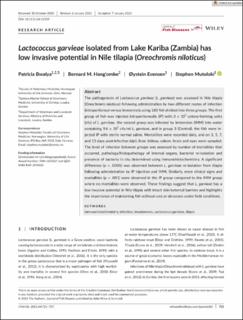| dc.description.abstract | The pathogenesis of Lactococcus garvieae (L. garvieae) was assessed in Nile tilapia (Oreochromis niloticus) following administration by two different routes of infection (intraperitoneal versus immersion), using 180 fish divided into three groups. The first group of fish was injected intraperitoneally (IP) with 3 × 105 colony-forming units (cfu) of L. garvieae; the second group was infected by immersion (IMM) into water containing 9.6 × 105 cfu/ml L. garvieae, and in group 3 (Control), the fish were injected IP with sterile normal saline. Mortalities were recorded daily, and on 3, 5, 7, and 13 days post-infection (dpi), liver, kidney, spleen, brain and eyes were sampled. The level of infection between groups was assessed by number of mortalities that occurred, pathology/histopathology of internal organs, bacterial re-isolation and presence of bacteria in situ determined using immunohistochemistry. A significant difference (p < .0001) was observed between L. garvieae re-isolation from tilapia following administration by IP injection and IMM. Similarly, more clinical signs and mortalities (p < .001) were observed in the IP group compared to the IMM group where no mortalities were observed. These findings suggest that L. garvieae has a low invasive potential in Nile tilapia with intact skin/external barriers and highlights the importance of maintaining fish without cuts or abrasions under field conditions. | |
